Samsung SSD 850 EVO (120GB, 250GB, 500GB & 1TB) Review
by Kristian Vättö on December 8, 2014 10:00 AM ESTRandom Read/Write Speed
The four corners of SSD performance are as follows: random read, random write, sequential read and sequential write speed. Random accesses are generally small in size, while sequential accesses tend to be larger and thus we have the four Iometer tests we use in all of our reviews.
Our first test writes 4KB in a completely random pattern over an 8GB space of the drive to simulate the sort of random access that you'd see on an OS drive (even this is more stressful than a normal desktop user would see). We perform three concurrent IOs and run the test for 3 minutes. The results reported are in average MB/s over the entire time.
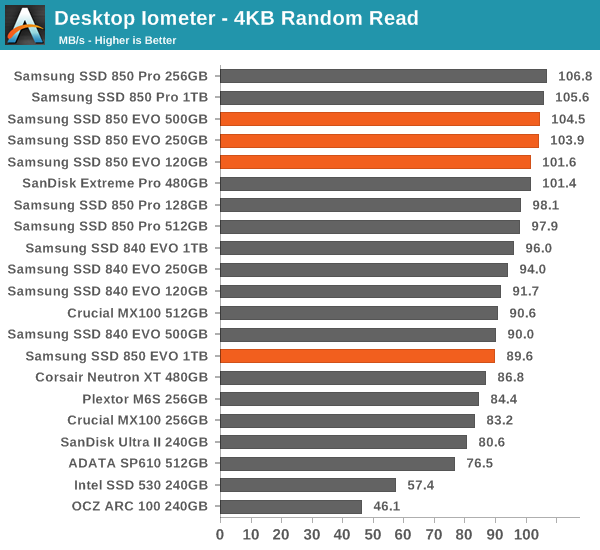
The models with the new MGX controller enjoy excellent random read performance, although the 1TB version isn't bad either. Without knowing the specifications of the MGX controller, it's hard to know what is causing the performance increase, but I still suspect it is due to a higher clock speed.
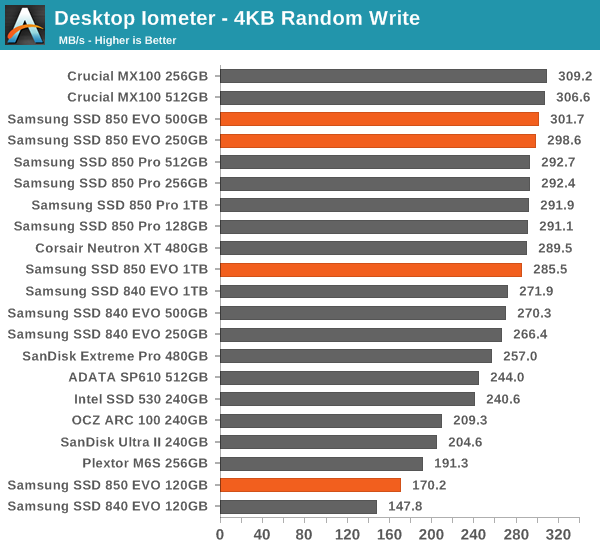
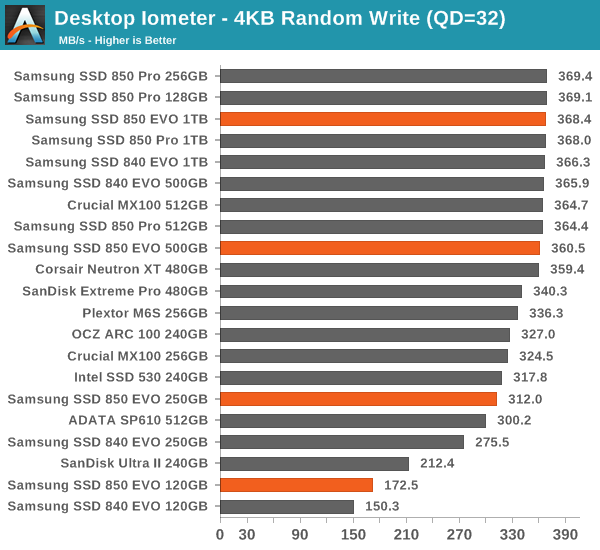
Random write performance also sees an increase across all capacities and is more or less on par with the 850 Pro at larger capacities.
Sequential Read/Write Speed
To measure sequential performance we run a 1 minute long 128KB sequential test over the entire span of the drive at a queue depth of 1. The results reported are in average MB/s over the entire test length.
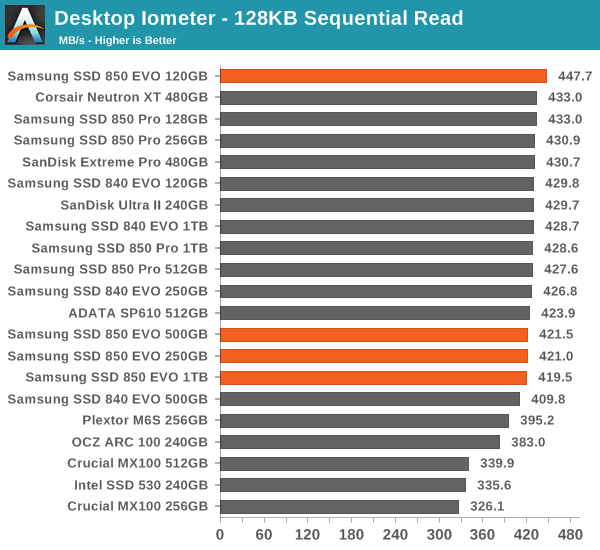
Sequential performance doesn't present any real surprises. Write speed at smaller capacities gets a small boost, but other than that the performance is typical SATA 6Gbps level.
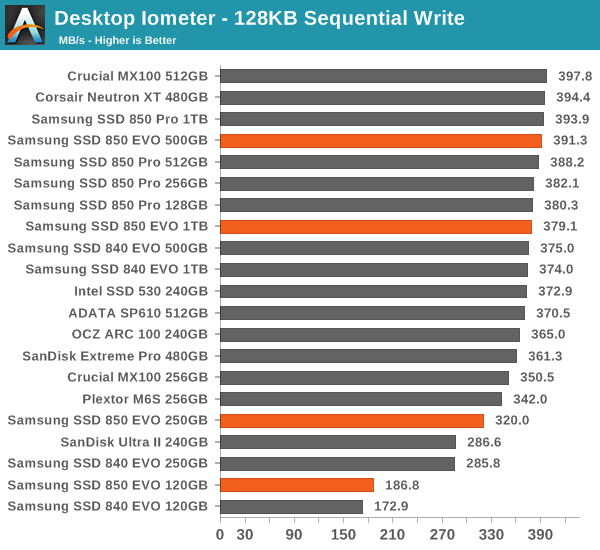
AS-SSD Incompressible Sequential Read/Write Performance
The AS-SSD sequential benchmark uses incompressible data for all of its transfers. The result is a pretty big reduction in sequential write speed on SandForce based controllers, but most other controllers are unaffected.
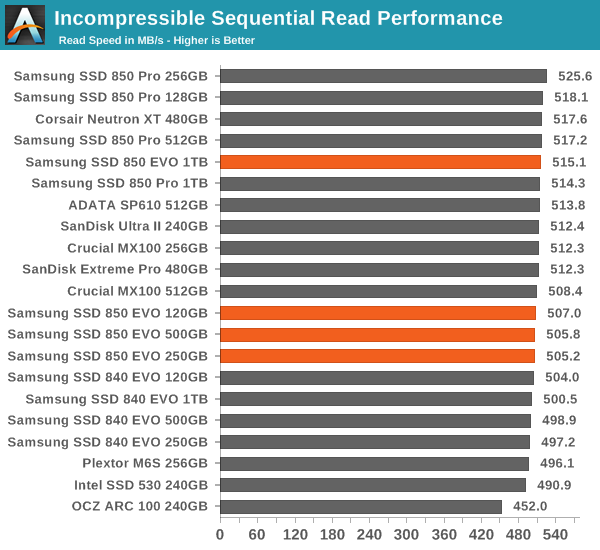
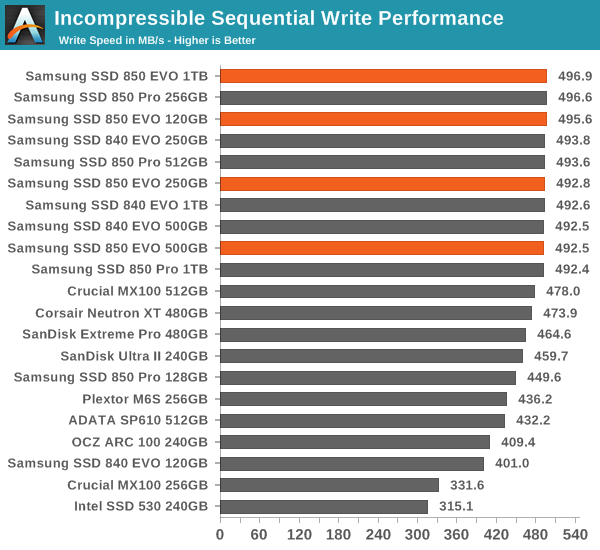










97 Comments
View All Comments
TEAMSWITCHER - Monday, December 8, 2014 - link
I'm in complete agreement. I'm not going to buy another 2.5" SSD before I can get an 850 Pro (512 GB) equivalent with an M.2 interface. I have two motherboards with empty M.2 slots waiting for the market to catch up. I know about the XP941, but the pricing isn't great. M.2 drives should cost almost the same as a 2.5" drive...especially after eliminating the worthless metal/plastic box.extide - Monday, December 8, 2014 - link
Seems to me like TLC will become the standard mainstream for 3D/VNAND, where as MLC will be pretty much only for high end/enterprise, somewhat like SLC was back in the day.MadDuffy - Monday, December 8, 2014 - link
Newegg prices (USD) are up:120 GB - 90
250 GB - 140
500 GB - 250
1 TB - 470
Email I received indicates these are promotional prices available through Dec 14th
casperes1996 - Monday, December 8, 2014 - link
Last page, fifth paragraph, last line:"If I was"
Should be: "If I were"
I know I'm a cunt for pointing it out, but I only do so because I generally think Anandtech offers fairly decently written articles, and I care too much about this sort of piss...
Sorry.
apudapus - Monday, December 8, 2014 - link
How is data retention with this type of TLC NAND? Can the drive be powered off for a week or a month before data gets corrupted? While the drive is powered on, I assume there are refresh features for stale (a.k.a. infrequently accessed) data.hojnikb - Monday, December 8, 2014 - link
If its up to jedec (i imagine it is) then its good for atleast a year.kgh00007 - Monday, December 8, 2014 - link
But in reality what are they going to be like? I don't think I'll buy another Samsung TLC drive after owning the 120 GB 840 EVO for the last while! It performs erratically, especially when resuming from hibernate. It can take anywhere from 10 secs to boot, up to 5 minutes, and I have applied the latest firmware and run the speed recovery app from Samsung. I have an mSata Crucial m500 240GB which is slower on paper, but in reality is much quicker and the performance is 100% consistent, it does the same thing, every time at the same speed!!MLC all the way for me without any turbowrite nonsense, just straight forward advertised speeds across the whole drive all the time, without loosing data due to poor charge retention along the way!
Lolimaster - Monday, December 8, 2014 - link
Your EVO is 120 and your other drive is 240, less nand, more erratic, simple. Look at the chart, you get consistent writes/read with 500-1TB models.kgh00007 - Saturday, December 13, 2014 - link
Less nand equals slower performance, not more erratic performance. But it should perform at it's given speed consistentantly. I have over 30% of the drive free and 10% set as over provisioning on the 840 EVO. There is no excuse for a 5 minute boot time with an SSD. I don't trust these Samsung drives after my experience!mlkmade - Monday, December 8, 2014 - link
So I'm confused as its not very clear...Is Turbowrite turned on for all your benchmarks?Is turbowrite needed to hit the the 540/520 read/write times? I saw the chart with TurboWrite on and off. So with turbowrite off this drive only gets 100mb/s ?
This article is very vague in regards to that.